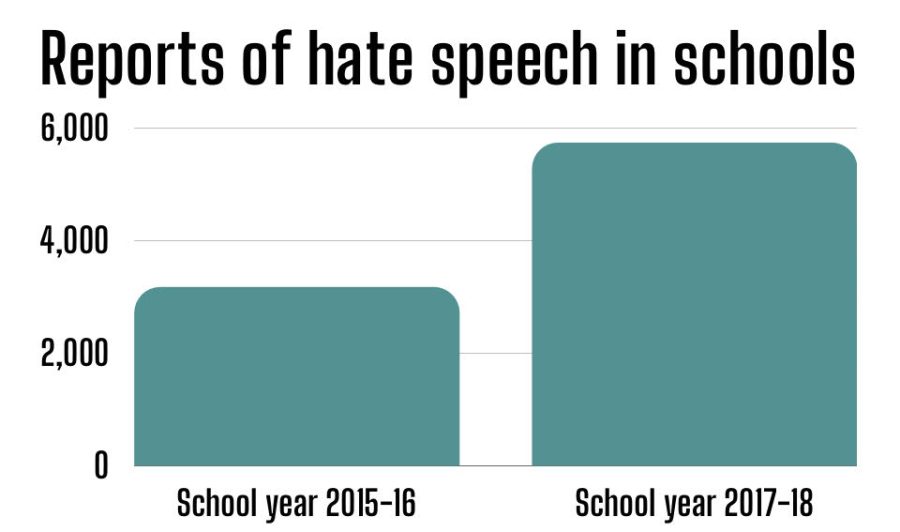Damaging terms: The gloomy effects of hate speech
Statistics from studies ran by The U.S. Government Accountability Office show the rise in hate speech reports in recent years. the amount nearly doubled in between 2015 and 2018.
December 10, 2022
The world has a monster that has been harming our nation. Every year it grows bigger and bigger, and recently, it has gotten significantly worse. Some deny its existence, some turn the other way, and some willingly keep it around. It has crept its way into the halls of our schools with the goal of ruining our culture and our environment. This monster? It’s the ever-increasing trend towards “hate speech.”
Hate speech usually appears as speech or writing that aims to threaten a particular group of people, usually on the basis of race, religion, or sexual orientation. According to a study from the U.S. Government Accountability Office, usage of hate speech in schools has nearly doubled in size from 2015 to 2018. And locally, the use of hate speech in Noblesville has grown as well.
In early November 2022, an orchestra student at NHS found hateful messages targeting members of the LGBTQ community scribbled onto the back of a music stand. The incident was immediately reported to school administrators. According to several students, the message had been there since the beginning of August. This means that for months, students had been exposed to clear and blatant hatred in a space that was considered by many to be a safe environment. A study ran in 2019 by the National Center for Biotechnology Information found that students exposed to hateful terms potentially manifest symptoms of “heightened stress, anxiety, depression, and desensitization.” To make things even worse, the U.S. Government Accountability Office study found that academic performances of students exposed to hate speech can also take a dive, claiming that situations like this can lead to “poor school performance, including lower grade point averages, standardized test scores, and poor attendance.”
According to Noblesville assistant principal Kevin Stuckwisch, disciplinary actions at NHS for hateful language directed towards students could vary from “a restorative conversation to potential expulsion.” Studies have shown, however, that the responses involving suspension or expulsion do not work. A study from 2021 run by the American Institutes for Research showed that “more severe exclusionary discipline has a consistent negative effect [on] future reported behavior.” Similarly, it was found by University of Wisconsin researcher Clark Thelemann that “exclusionary discipline programs do not offer an effective intervention to student behavioral concerns.” So, what can a school do that would be more effective in limiting the use of hateful speech?
For starters, it is important to recognize that the students spreading hate are struggling themselves. The reason suspensions do not work is that they usually only lead to more anger and frustration for students, which ultimately leads to more hatred being spread. It would be significantly more beneficial for the school’s environment if the school were to work towards helping students realize how their actions can affect others, rather than simply punishing them and moving on. Secondly, the school should be encouraging students to speak out when they experience or witness discrimination. In 2018, it was reported by the Bureau of Justice Statistics that only 44 percent of bullied students had reported their experiences to an adult at school.
Schools should not be a space that students fear, but that has become an unfortunate reality for students across the country. The truth is that every part of a school suffers from this toxic culture; social environments get torn apart, academic success falls, unacceptable behavior increases, and hatred wins. Hate speech is a monster that has infested our society, but it is a monster that can be limited and brought down. Schools just need to put in the effort.




